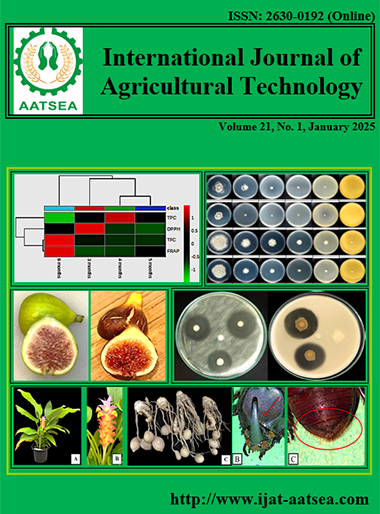Efficacy of the strains of Pseudomonas and Acinetobacter as biocontrol agents against bacterial wilt disease in chili
Main Article Content
Abstract
Bacterial wilt of chili (Capsicum spp.) caused by Ralstonia solanacearum is an economically damaging disease of chili production in Thailand and tropical regions worldwide. This study screened bacteria isolated from the rhizosphere soil of healthy chili plants from Surin, Ratchaburi, and Chanthaburi provinces with strong antagonistic activity against R. solanacearum. A dual-culture assay revealed the best three isolated strains, D402-5(3), M601-4, and KJB01, which were able to inhibit the growth of the pathogen. D402-5(3) showed the largest inhibition zone diameter of 2.63 cm, followed by M601-4 and KJB01 with diameters of 2.50 cm and 2.33 cm, respectively. By morphological observation and molecular characterization via 16S rDNA gene sequencing analysis, D402-5(3) and KJB01 were identified as Pseudomonas sp., and M601-4 was identified as Acinetobacter sp. The suppression of bacterial wilt disease in chili by the three antagonistic strains was carried out by pot experiments in the greenhouse. D402-5(3) exhibited the highest biocontrol efficacy of 73.12% on the 12th day post R. solanacearum inoculation, followed by M601-4 and KJB01 with biocontrol efficacies of 58.19% and 43.2%, respectively. Plant growth-promoting traits and lytic enzyme production abilities of the three strains were detected. The results showed that D402-5(3) was able to produce cellulase and protease, KJB01 produced only protease, and M601-4 could solubilize phosphate and fix nitrogen.
Article Details

This work is licensed under a Creative Commons Attribution-NonCommercial-NoDerivatives 4.0 International License.
References
Achari, G. A. and Ramesh, R. (2014). Diversity, biocontrol, and plant growth promoting abilities of xylem residing bacteria from solanaceous crops. International Journal of Microbiology, 2014:296521.
Arwiyanto, T., Maryudani, Y. S. and Nurcahyanti, S. D. (2010). Protection of eggplant and chilli from bacterial wilt (Ralstonia solanacearum) with antagonistic bacteria. XXVIII International Horticultural Congress on Science and Horticulture for People (IHC2010): International Symposium on Organic Horticulture: Productivity and Sustainability, Lisbon, Portugal, 421-425.
Bonaterra, A., Badosa, E., Daranas, N., Francés, J., Roselló, G. and Montesinos, E. (2022). Bacteria as biological control agents of plant diseases. Microorganisms, 10:1759.
Dowarah, B., Agarwal, H., Krishnatreya, D. B. Sharma, P. L., Kalita, N. and Agarwala, N. (2021). Evaluation of seed associated endophytic bacteria from tolerant chilli cv. Firingi Jolokia for their biocontrol potential against bacterial wilt disease. Microbiological Research, 248:126751.
Fegan, M. and Prior, P. (2006). Diverse members of the Ralstonia solanacearum species complex cause bacterial wilts of banana. Australasian Plant Pathology, 35:93-101.
Hankin, L. and Anagnostakis, S. L. (1977). Solid media containing carboxymethylcellulose to detect cx cellulase activity of microorganisms. Journal of general microbiology, 98:109-115.
Hayward, A. C. (1991). Biology and epidemiology of bacterial wilt caused by Pseudomonas solanacearum. Annual Review of Phytopathology, 29:65-87.
Hu, H. Q., Li, X. S. and He, H. (2010). Characterization of an antimicrobial material from a newly isolated Bacillus amyloliquefaciens from mangrove for biocontrol of Capsicum bacterial wilt. Biological Control, 54:359-365.
Kashyap, A. S., Manzar, N., Rajawat, M. V. S., Kesharwani, A. K., Singh, R. P., Dubey, S. C., Pattanayak, D., Dhar, S., Lal, S. K. and Singh, D. (2021). Screening and biocontrol potential of rhizobacteria native to gangetic plains and hilly regions to induce systemic resistance and promote plant growth in chili against bacterial wilt disease. Plants, 10:2125.
Lozada, D. N., Bosland, P. W., Barchenger, D. W., Haghshenas-Jaryani, M., Sanogo, S. and Walker, S. (2022). Chile pepper (capsicum) breeding and improvement in the “multi-omics” era. Frontiers in Plant Science, 13:879182.
Masi, C., Gemechu, G. and Tafesse, M. (2021). Isolation, screening, characterization, and identification of alkaline protease producing bacteria from leather industry effluent. Annals of Microbiology, 71:24.
McLaughlin, R. J. and Sequeira, L. (1988). Evaluation of an avirulent strain of Pseudomonas solanacearum for biological control of bacterial wilt of potato. American Potato Journal, 65:255-268.
Mohammed, A. F., Oloyede, A. R. and Odeseye, A. O. (2020). Biological control of bacterial wilt of tomato caused by Ralstonia solanacearum using Pseudomonas species isolated from the rhizosphere of tomato plants. Archives of Phytopathology and Plant Protection, 53:1-16.
Patel, S., Jinal, H. N. and Amaresan, N. (2017). Isolation and characterization of drought resistance bacteria for plant growth promoting properties and their effect on chilli (Capsicum annuum) seedling under salt stress. Biocatalysis and Agricultural Biotechnology, 12:85-89.
Sukhawatthanakun, K. (2022). Marketing channels of chili in the upper northeastern region of Thailand. Kasetsart Journal of Social Sciences, 43:637-644.
Tan, S., Jiang, Y., Song, S., Huang, J., Ling, N., Xu, Y. and Shen, Q. (2013). Two Bacillus amyloliquefaciens strains isolated using the competitive tomato root enrichment method and their effects on suppressing Ralstonia solanacearum and promoting tomato plant growth. Crop Protection, 43:134-140.
Thamkhongdee, A., Chinachanta, W., Chromkaew, Y., Chaiwan, F. and Shutsrirung, A. (2019). Abilities of nitrogen fixing bacteria in enhancing growth of arabica coffee seedling. Journal of Agriculture, 36:79-91.
Thongwai, N. and Kunopakarn, J. (2007). Growth inhibition of Ralstonia solanacearum PT1J by antagonistic bacteria isolated from soils in the northern part of Thailand. Chiang Mai Journal of Science, 34:345-354.
Wang, Z., Luo, W., Cheng, S., Zhang, H., Zong, J. and Zhang, Z. (2023). Ralstonia solanacearum – A soil borne hidden enemy of plants: Research development in management strategies, their action mechanism and challenges. Frontiers in Plant Science, 14:1141902.
Xue, Q. Y., Chen, Y., Li, S. M., Chen, L. F., Ding, G. C., Guo, D. W. and Guo, J. H. (2009). Evaluation of the strains of Acinetobacter and Enterobacter as potential biocontrol agents against Ralstonia wilt of tomato. Biological Control, 48:252-258.
Yuliar., Nion, Y. A. and Toyota, K. (2015). Recent trends in control methods for bacterial wilt diseases caused by Ralstonia solanacearum. Microbes and Environment, 30:1-11.


